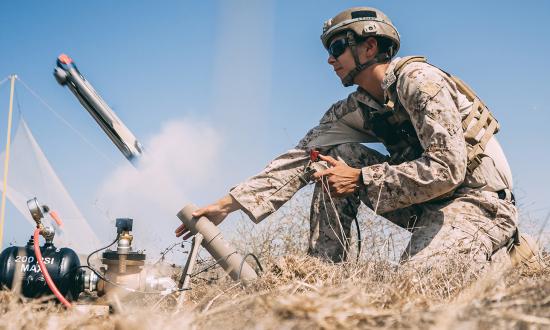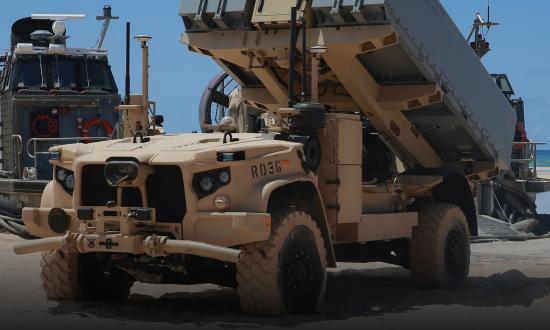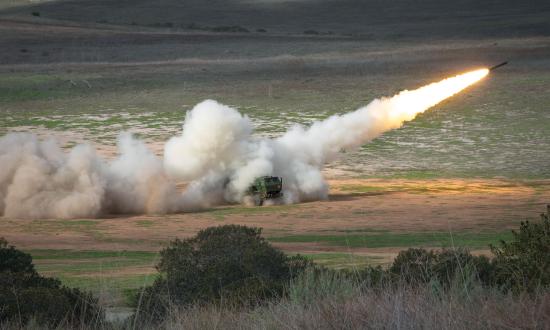Maneuver warfare is the doctrinal bedrock of the U.S. Marine Corps. Enshrined in Marine Corps Doctrinal Publication 1 (MCDP-1), Warfighting, it conceptualizes the enemy as a system and seeks paths around enemy surfaces to attack critical vulnerabilities. It shuns formulaic approaches to warfare and stresses artistic, creative approaches to new problem sets. Why, then, does the service restrict how the Marine air-ground task force (MAGTF) fights? Infantry are always the main effort.
The Marine Corps will not be able to fight effectively or win future conflicts with this limited playbook. To contribute to a future Indo-Pacific conflict, the service must be able to rapidly shift the main effort among multiple warfighting functions and unit types.
Although the Pacific campaign of World War II was fought decades before the Marine Corps conceptualized maneuver warfare, the island-hopping strategy U.S. forces employed reflected its basic principles: avoid enemy strengths and attack enemy vulnerabilities. The immediate goal of many of these island operations was to capture airfields for land-based aircraft at useful positions within enemy territory. The joint force “maneuvered” aircraft flight ranges around the theater at the operational level to better attack the enemy system at that level.
Picture that strategy adapted for today: land-based antiship missile–engagement zones maneuvering through the theater, seizing maritime terrain, denying enemy fleet movement, and providing cover for follow-on naval maneuver. This is the expeditionary advanced base operations (EABO) concept, particularly the antiaccess/area-denial (A2/AD) version, using modern Marine Corps artillery. The only difference is doctrinal, in that these fires assets are not—but should be—considered maneuver elements at the operational level of warfare.
Credit: U.S. Marine Corps (Olivia G. Knapp)
Currently, the Marine Corps views only infantry as maneuver elements; indeed, “maneuver” often is considered synonymous with “infantry.” For example, if Marines say they are doing something in support of maneuver, no one thinks they are supporting howitzers, a truck company, or the wing. This is an important point. Only maneuver elements can be the main effort, and all support must go to the main effort as the bid for success. But a MAGTF planner who designates the main effort solely according to this convention may doom an entire operation to failure, depending on the composition of the enemy system in question.
Under the Marine Corps’ historic task organization, having infantry as the main effort made sense. It created a traditional combined-arms dilemma and supported the unit type usually most suited to bring combat power to bear on an enemy. But it is an inherently formulaic and restrictive approach that should not be applied to a newly designed force with new capabilities. Warfighting does not restrict the term “maneuver” to the infantry. It conceptualizes maneuver elements as anything that can be brought to bear on the enemy’s vulnerabilities. Why not embrace this in reality, in both training and application?
Imagine a joint force fighting to retake maritime terrain from a hegemonic peer, spearheaded by a highly adaptable MAGTF—one that can reorder itself for battle based on the enemy vulnerability in front of it. Such a force could identify an enemy system and shift between main efforts at a speed that outpaces the enemy.
More specifically, consider the following example:
The enemy fleet holds a position of strength in key maritime terrain, flanked by atolls that are home to its air defense systems. Unmanned and lightly guarded, those air defenses are identified as a vulnerability in the enemy’s naval system. To force the enemy fleet to move to a more favorable position for the joint force to strike, the Marine Corps maneuvers over-the-horizon fires onto the lightly defended atolls. The MAGTF commander designates his fires assets as the main effort at the operational level. The fires commander selects the most advantageous position for his launchers, and resources move to support him.
At the tactical level, the MAGTF commander designates components of the aviation combat element (ACE) as the initial main effort, as he plans to put the launchers on an island with beaches unsuitable for landing heavy equipment. Marine Corps infantry support the ACE by conducting raids on enemy air defenses, disabling them, and consolidating elsewhere on land to create a fledgling EAB. Aircraft then deliver the launchers, and the tactical main effort shifts to the infantry maneuvering on the island in support of the EAB.
Ground-based observers using drones spot the enemy fleet over the horizon and transmit an antiship missile call for fire without using national strategic-level assets. The local fires commander goes ashore as the bid for success at the campaign level; he has approval authority to fire on the enemy fleet, shortening the kill chain. He does so, sending the surviving enemy ships in a mad dash to exit the weapon-engagement zone and right into follow-on naval maneuver by the friendly fleet.
This is a best-case scenario, written without consideration of enemy actions and the ever-present friction of war. While this does not make it null and void, reality will not be so easy.
Of note, this is not an argument for relegation of the infantry. In fact, the batteries that go ashore on EABs should be hybrid cannon-missile batteries, able to transition to traditional fire support to better support infantry engaged with the enemy on the ground. It is merely an argument for a more fluid MAGTF with more options for bringing force to bear on an enemy. Some deployed MAGTFs have experimented with similar ideas in recent years, designating parts of either the logistics combat element (LCE) or ACE as main efforts; however, a disconnect exists between those few instances and service-level training. That is a dangerous disconnect. Innovation should be continual and from everywhere, but Marines should practice things before they must do them in combat.
The capabilities of the future MAGTF make the Marine Corps well suited to contribute significantly to the joint force’s conduct of the next naval war. The only limit is doctrinal, but the doctrine in question allows for much more than the status quo. It is up to the Marine Corps to determine how much it contributes to a future naval campaign; recent force design has the potential to make the service’s role more significant.







